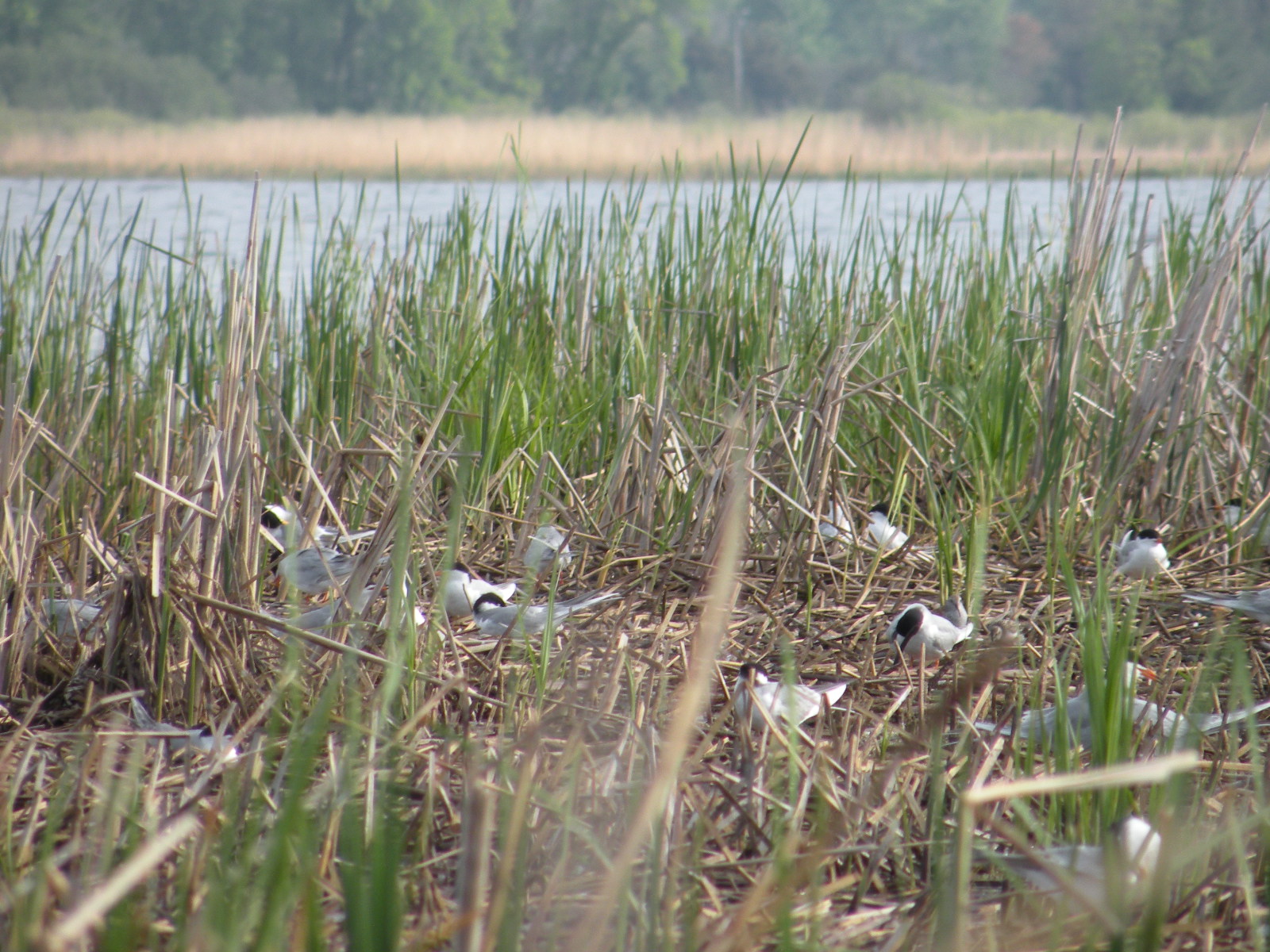Female Forester’s tern. Photo by Arlene Koziol
Terns are in the same family as gulls and skimmers, and 40 tern species are found worldwide. The arctic tern migrates from Antarctica and back again over a six month period. Their journey is not necessarily in a straight line, and on average the round trip migration distance covers an unbelievable 44,000 miles. All four tern species regularly found in Wisconsin, Forster’s tern, black tern, common tern, and Caspian tern are listed as state endangered. Wisconsin DNR and other groups have developed innovative ways to assist these species, and particular progress has been made with Forster’s terns.
Numerous Forster’s terns mingle in native vegetation in a wetland. Photo by Daryl Christensen
The Forster’s tern is a colony nester. Bird colonies are usually found on sites that are well protected from the usual terrestrial predators. Because colony nesting birds only congregate for a small portion of the season, local predator populations do not boom as they might with a permanent high energy food source. Forster’s terns breed in large marshes with abundant emergent vegetation, and most of the breeding population in Wisconsin inhabits the east central portion of the state or lower Green Bay.
In pre-settlement days, an estimated 10 million acres of wetlands existed in Wisconsin according to Wisconsin DNR. Around 50 percent of those acres were destroyed because of conversion to agriculture, urban area, or other uses. Some colony nesters have a remarkably high site fidelity, meaning that they return to the same breeding site year after year. Forster’s terns are more nomadic than others in this sense. They require specific water levels for optimal nest success; plenty of water to maintain prey populations and deter predators, but not so much that their source of cover is below the water line. Historically Forster’s terns had many more options when choosing a colony site. Greater habitat choice led to more successful nests and higher populations.
A Forster’s tern on a nest platform, Photo taken by Daryl Christensen in 1983 or 1984
Because of low nest success and declining populations, the Wisconsin DNR began deploying nesting platforms for Forster’s terns in 1983. Nest platforms provide high quality nesting sites when natural substrates are of low quality or in short supply. After eggs are laid, rising water can easily submerge nests. Fluctuation in marsh water levels is likely exacerbated by hard surfaces and row crop cultivation due to their low water infiltration potential. Nesting platforms float on the water surface. They are attached loosely to a pole which allows them to rise and fall in response to changing water levels.
Nesting platforms significantly increase nest success, and 100 percent of deployed platforms were utilized by terns in 2018. This year at Lake Puckaway, 200 breeding pairs produced 259 eggs without the assistance of platforms. At Grand River Marsh, 19 breeding pairs that were occupying tern platforms produced 58 eggs. This means that breeding pairs of Forster’s terns were able to produce over two times the eggs using platforms than on natural substrate. Lake Puckaway flooded after this nest survey was completed, and all eggs were lost. Forster’s terns do renest, but their egg production decreases after each nesting attempt.
The Wisconsin DNR plans to increase the number of tern platforms to 150. Ryan Zabs, a Sun Prairie Eagle Scout, reached out to Goose Pond Sanctuary in search of his final Eagle Scout project. He helped us take a huge step towards those 150 by building 50 platforms in a single weekend. Sumner Matteson with Natural Heritage Conservation Bureau at WIDNR generously provided funding for the platform materials.
Forster’s tern nest platform, photo by Daryl Christensen
While the success of tern platforms certainly is exciting, it must be noted that this is not a permanent solution. Continued restoration of large wetlands and further protection of coastal wintering grounds is the best hope to keep Forster’s terns on the Wisconsin landscape now and far into the future.
Written by Graham Steinhauer, Goose Pond Sanctuary land steward









